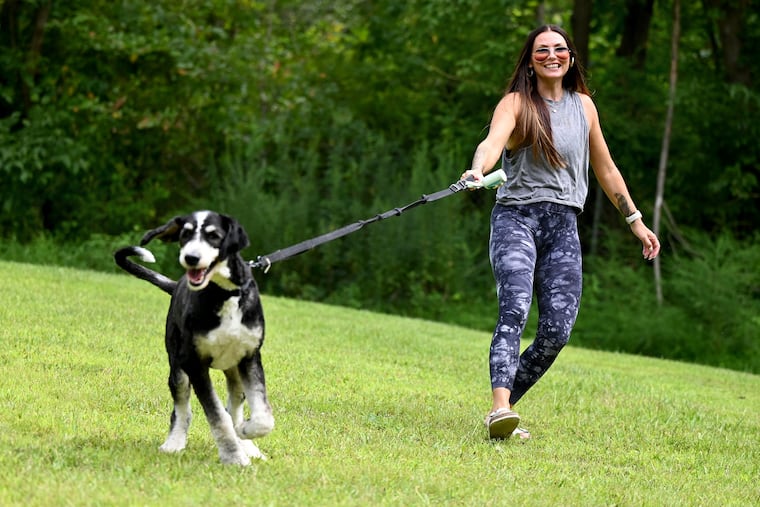You’re probably holding your dog’s leash the wrong way — and risking an injury
Broken fingers, traumatic brain injuries and shoulder sprains are among the most common injuries from dog-walking.

Maryalice Dempsey is an early riser who gets to the gym before her workday begins. But first, she takes her 100-pound, 10-month-old Bernedoodle puppy, Bowie, for a walk in their Mount Laurel neighborhood.
Dempsey’s early-morning routine took a nasty turn one day in July, when Bowie took off after her cat.
The metal carabiner that connected the dog’s poop bag holder to his leash snapped open and impaled her thumb. She felt a sharp pain, but it was too dark to tell what exactly had happened.
“I thought the hook had just clipped my left thumb, but I couldn’t pull it off,” said Dempsey, 43, who discovered the extent of her injury once back inside.
Her husband took her to the emergency room where doctors removed the hook and sutured the puncture wound. After a few days, she was given a plastic splint until the stitches dissolved.
Finger fractures, shoulder sprains, and traumatic brain injuries are among the most common dog-walking injuries, according to a new study by Johns Hopkins University. Between 2001 and 2020, more than 400,000 people went to the ER for injuries sustained while walking a dog, according to the study, which was published earlier this year in the journal Medicine & Science in Sports & Exercise.
How to avoid injury
Dogs are unpredictable and can be easily distracted. They don’t understand traffic and other lurking dangers. At the same time, walking your dog can seem like a good time to multitask — chat on the phone, read an email, enjoy the scenery. Accidents can happen when the dog and owner are both distracted.
“If you’re paying attention to your dog, you will get a visual cue and feel tension on the leash before it’s too late,” said Michael Rivlin, the hand surgery specialist at Rothman Orthopaedic Institute who treated Dempsey. “You need to know how to walk your dog and the dog needs to know how to be walked, and that requires proper training that can help avoid risky behaviors.”
Using the right type of leash and holding it in the right way will keep you safe if the dog starts to pull unexpectedly. Grip the leash in the palm of your hand with the thumb locking the leash inside the palm, so if your dog suddenly lurches, you can instantly let go.
“It’s better for the dog to chase after the squirrel rather than trying to hold onto the dog, especially if it’s a big dog,” said Rivlin.
Never wrap the leash around your hand and wrist because when the dog takes off, the leash immediately goes from loose to high tension, which can create a rotational force leading to twisting injuries, including finger fractures and dislocations, and wrist injuries, Rivlin said.
Use shorter (6 to 8 feet), nonretractable leashes, which are less likely to get tangled around your legs and cause falls. Retractable leashes can sometimes make your dog more difficult to control. Hands-free dog-walking belts are a good option, especially for bigger dogs, but it’s important to know how to properly use one.
Dog-walking injuries are common
The Johns Hopkins study looked at U.S. emergency department data between 2001 and 2020, during which time 425,000 adults were seen with injuries related to walking a dog with a leash. The study’s findings do not capture the many more people who may have gone to their primary care doctor, an urgent care center, or directly to a specialist, said the study’s lead author, Ridge Maxson, a fourth-year medical student at the Johns Hopkins University School of Medicine in Baltimore.
Women and older dog walkers between the ages of 40 and 64 were at greater risk for serious injuries.
Women accounted for 75% of the patients in the study and were found to be 50% more likely to experience a fracture, compared with men, said Maxson, who worked alongside Edward McFarland, a professor of orthopedic surgery at Johns Hopkins University School of Medicine.
Older adults were three times more likely to get hurt from a fall, more than twice as prone to sustain a fracture, and had more than a 60% chance of having a traumatic brain injury. These falls are likely attributed to age-related changes in balance, muscle strength, and vision, Maxson said.
As balance and bone health start to wane as we get older, studies have shown that strength and balance exercises decrease the risk of falls and fractures for older adults, said Maxson. He encourages adults to exercise to increase balance and bone strength.
“Consult your doctor about ways they can help you lower your risk for serious injury while walking your furry friend,” he said.
A growing problem
By the end of the 20-year study period, the annual number of injuries more than quadrupled. One theory is that there are more dog owners — 65 million households own a dog, according to Statista.com. People are also taking advantage of dog walking for exercise, especially those who work from home and appreciate the break in the day.
Be aware of your surroundings, keeping your head up and eyes peeled for anything that may cause your dog to bolt. Try to avoid areas where you know your dog is more likely to be distracted.
Dempsey still walks Bowie very early in the morning, but she now has an all-rubber poop bag holder and leash attachment.
“If it happens again, I’ll just let the leash go,” she said. “I was lucky I didn’t break my wrist or have something happen way worse.”